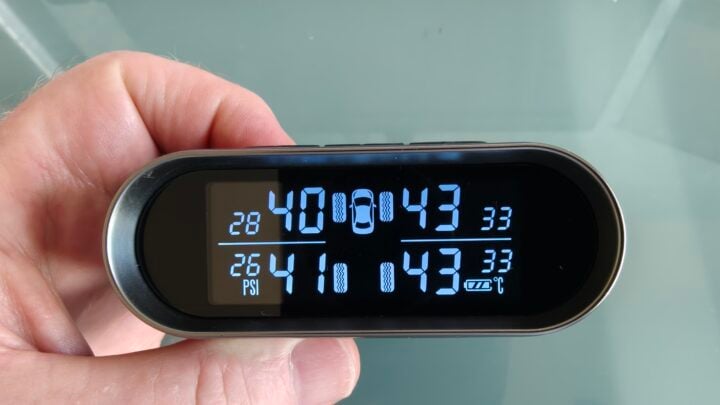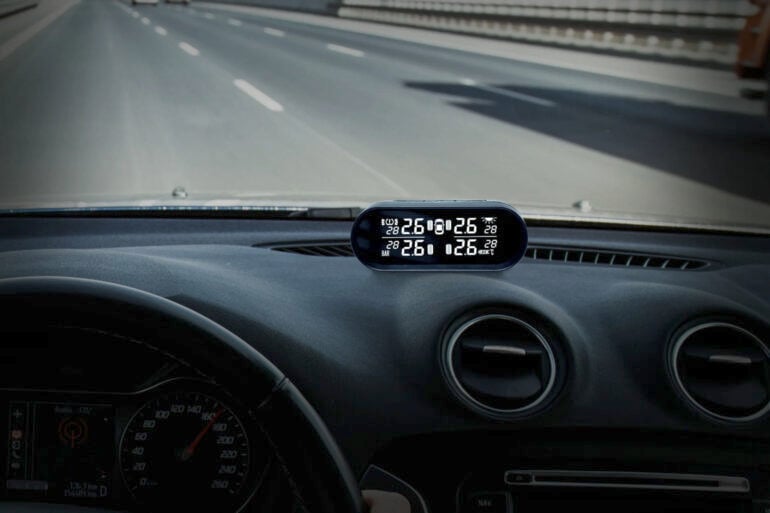In a bygone era, if you wanted to check your car’s tyre pressure, you had to go to a service station. Fortunately, there are more sophisticated methods now. Depending on how technical you want to get, some home tyre pressure monitoring systems even use Bluetooth to give you real-time data.
A tyre pressure monitoring system (TPMS) is a device that monitors your vehicle’s tyre pressures and those of your trailers. It is a safety device that alerts you to an issue before it becomes a more significant problem.
Many high-end modern cars come with a built-in TPMS that alerts you via your dashboard display when a tyre is losing pressure or running at a high temperature. Once you receive the alert, you should pull over as soon as possible and inspect the suspect tyre.
If you do not, you could lose control of the car due to a loss of pressure. Early detection will also prevent you from driving on a flat tyre that can most likely be repaired rather than destroyed by driving on it, resulting in an expensive replacement.
I first became a fan of TPMS devices when I bought an off-road caravan and faced the real possibility of a flat tyre causing major damage. Unlike the wheels on your car, it takes even longer to realise you have an issue with a trailer tyre than in the vehicle you’re driving.
Testing the Promata Mata 2 TPMS
I have been testing a set of Promata Mata 2 TPMS with my car and trailer. Before this, I had used two other TPMS from different brands. My issue with those previous devices had been intermittent reception between the sensors and the in-car monitor.
A TPMS is composed of up to three parts. First, a tyre sensor that can be installed either internally within the tyre by a tyre mechanic or externally by yourself, as a sensor that screws onto the tyre valve. The second part is a means to monitor the pressure inside your vehicle, which could be a dedicated display or an app on your smartphone. The third part is an optional booster that improves the coverage between the vehicle and the trailer if reception is poor.
After spending my money on my first setup, which plugs into a cigarette lighter socket, I experienced poor reception. The same issue occurred with the solution that used a smartphone app and Bluetooth. The moral of the story was that I should have bought a quality solution first.
Promata assured me that their solution would work for my setup, and it was even unlikely that I would need the optional booster. So far, I have tested it with a box trailer, and everything is working perfectly.

The tyre sensors are easily attached, and for the car solution, you can monitor up to 10 tyres (a truck version is available that will monitor up to 34 tyres). Each sensor is permanently attached to the valve stem of each tyre and uses a locking nut to keep it in place and minimise theft. Each tyre sensor uses a button battery that is expected to last approximately two years.
The Mata 2 display is a very stylish carbon fibre box that measures 9 x 8 x 4 cm. It’s designed to be attached to your dashboard, allowing you to view it easily. An integrated solar panel charges it when exposed to the sun. The display also features a USB-C port for charging, but it should not be necessary if you receive sufficient solar energy.
Your only maintenance of the TPMS is to change the button batteries when the display indicates a low battery. The sensors are labelled for each tyre and work out of the box with no setup required unless you want to customise the settings.

The display shows the tyre pressure for all four tyres and their corresponding temperatures. If a trailer is attached, a second screen will scroll automatically, showing trailer tyres. Battery and solar charging indicators are also shown on each screen.
Each pair of tyres, such as the front or rear, can be adjusted for minimum and maximum tyre pressure and temperature. The supported pressure range is 7-99 PSI. Based on this setting, an audible alarm will sound and the display will flash if the minimum or maximum is exceeded. Having this level of customisation is great, as my caravan tyre pressures run at up to 15psi higher than those of my car.
In my particular setup, my caravan uses air bags, which, like a tyre, also work with a preset pressure and can also develop a puncture. The Promata external sensors can also be attached to the airbag manual valves to monitor the airbag pressures. This again will ensure you are alerted before damage occurs.
Should you get a TPMS?
Time will tell on one of my longer caravan trips whether I will need the extra booster unit, but at least this time I know I am using a quality product that is designed to do the job. The range without a booster is quoted at 10m, while with a booster, it is 25m.
The Promata Mata 2 TPMS, with four external sensors, starts at $199, which will pay for itself if you save one tyre. TMPS kits can be bought directly from Promata, Supercheap Auto or Bunnings.
We put a lot of faith in our tyres every day, sometimes travelling at high speed. An inexpensive TPMS system can give you that extra bit of peace of mind, saving you, your occupants and your tyres.








